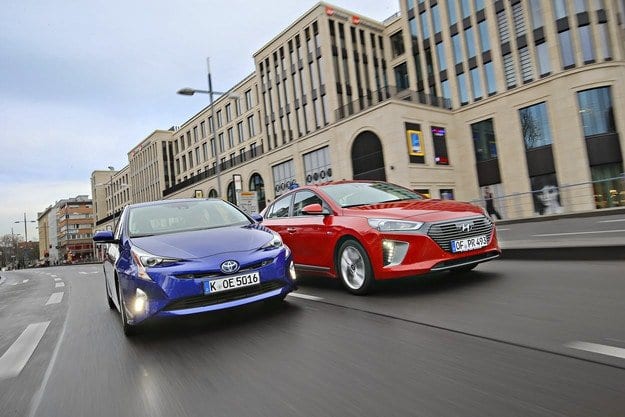
Test drive Hyundai Ioniq vs Toyota Prius: hybrid duel

It's time to do a thorough comparison of the two most popular hybrids on the market.
The world is an interesting place. Hyundai's new hybrid model, which managed to make a splash in the market, is actually a stylish and elegant car with a discreet look, and the founder of this class, the Prius, in its fourth generation, looks more extravagant than ever. The aerodynamically optimized bodywork of the Japanese model (0,24 Wrap Factor) is clearly trying to showcase the Prius's individuality and economy in every possible way - which, in fact, distinguishes it from other very similar hybrid models. Toyota like Yaris, Auris or RAV4.
Currently, the Ioniq is Hyundai's only hybrid model, but it is available with three types of electrified drive – a standard hybrid, a plug-in hybrid and an all-electric version. Hyundai is betting on the concept of full hybrids, and unlike the Prius, power from the engine and electric motor to the front wheels is not through a continuously variable planetary transmission, but through a six-speed dual-clutch transmission.
Ioniq - the car is much more harmonious than the Prius
With regard to the interaction of the various components of the hybrid drive, both models do not give any serious reasons for comment. However, the Hyundai has one major advantage: Thanks to its dual-clutch transmission, it sounds and behaves like a regular petrol car with an automatic transmission – perhaps not very agile, but never annoying or stressful. Toyota has all the familiar aspects that usually result from using a continuously variable transmission - acceleration is somehow unnatural and with a noticeable "rubber" effect, and when boosted, the speed remains constantly high as speed increases. To be honest, sometimes unpleasant drive acoustics really have their positive sides - you instinctively begin to try to be more careful with gas, which reduces the already low fuel consumption.
When it comes to efficiency, the Prius is undeniable. Although its battery pack (1,31 kWh) - as with the Ioniq - does not allow charging from the mains or from the charger, the car has an EV mode for all-electric propulsion. If you walk very carefully with your right foot, then in urban conditions the 53-kilowatt electric motor can drive the car completely silently for an unexpectedly long time before turning on the 98 hp gasoline unit.
The Prius averaged just 5,1L/100km in the test, a respectable achievement for a 4,50m petrol car to say the least. Shorter by seven centimeters, but heavier by 33 kilograms Ioniq is close to this value, but still slightly inferior to it. Its 105 hp internal combustion engine. it typically kicks on earlier and more often to support the 32kW electric motor, so Ioniq's average consumption is about half a liter per 100km higher. However, in our special 4,4L/100km standard cycle for economical driving, this model is fully equivalent to the Prius, and on the highway it is even more fuel efficient.
Ioniq is more dynamic
The Ioniq accelerates from standstill to 100 kilometers per hour, a full second faster and overall appears to be the more dynamic of the two vehicles. Another, even more important point: Hyundai, equipped as standard with adaptive cruise control, lane keep assist and xenon headlights, if necessary, stops at 100 km / h two meters ahead of Toyota; in the 130 km / h test, the difference now increases to seven meters. This is worth a lot of valuable points for the Prius.
It is interesting to note, however, that unlike its predecessors, the Prius is surprisingly agile on the road with more dynamic driving. It handles unexpectedly well in corners, the steering gives excellent feedback and the seats have solid lateral support. At the same time, its suspension is impressive in that it absorbs various irregularities in the road surface. Hyundai also drives well, but lags behind Toyota in this indicator. Its handling is a bit more indirect, otherwise the comfortable seats would have better lateral body support.
The fact that the Ioniq looks more conservative compared to the Toyota has a mostly positive effect, especially in terms of ergonomics. This is a solid car, the quality and functional interior of which does not significantly distinguish it from many other models in the Hyundai lineup. Which is good, because here you feel almost at home. The atmosphere in the Prius is emphatically futuristic. The sense of space is enhanced by the shifting of the instrument panel in the middle of the dashboard and the extensive use of lightweight but decidedly cheap plastics. Ergonomics, let's say, wayward - especially the control of the infotainment system requires attention and distracts the driver.
There's a lot more rear seating on the Prius than on the Ioniq, both for knees and headroom. Hyundai, on the other hand, offers a significantly larger and more functional trunk. However, its rear window does not have a windshield wiper like the Prius - a small but significant plus for the Japanese model.
Similar prices, but significantly more hardware in the Ioniq
Hyundai's pricing is clearly directed against the Prius, with the Koreans offering significantly better equipment at similar prices. Both Hyundai and Toyota offer really good warranty conditions in our country, including for the battery. In the final table, the victory went to Ioniq, and deservedly so. Toyota has to work hard to bring the Prius back to its leading position until recently.
CONCLUSION
1.HYUNDAI
Instead of stylistic provocations, Ioniq prefers to impress with practical qualities - everything happens easily, and there are practically no serious flaws. Obviously, the growing popularity of the model is well deserved.
2.TOYOTA
The Prius offers better suspension comfort and a more dynamic engine - a fact. Since then, however, the Prius has not performed better in any discipline and has stopped significantly worse. However, the uniqueness of its design cannot be denied.
Text: Michael von Meidel
Photo: Hans-Dieter Zeifert